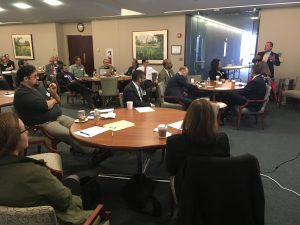On Thursday, February 23, 2017, APAPASE and the Delaware Valley Regional Planning Commission (DVRPC) co-hosted a breakfast event about PennDOT Connects. The event, which took place at the American College of Physicians building in Philadelphia, featured Pennsylvania Department of Transportation (PennDOT) Secretary Leslie Richards, Brian Hare of PennDOT, and Elizabeth Schoonmaker of DVRPC, presentations are available here. Secretary Richards kicked off the event with a twenty-minute presentation where she explained transportation’s role in connecting communities and supporting economic development. Under the PennDOT Connects initiative, PennDOT will take an earlier and more active role in reaching out to communities to enhance engagement with local communities and improve transportation-project planning, design, and delivery so that transportation investments support a community’s vision and goals.
The new approach to project planning and development goes beyond Linking Planning and NEPA and expands the department’s requirements for engaging local and planning partners by requiring collaboration with stakeholders before project scopes are developed. PennDOT Connects aims to transform capital and maintenance project development by ensuring that community collaboration happens early, and that each project is considered in a holistic way for opportunities to improve safety, mobility, access, and environmental outcomes for all modes and local contexts. Earlier collaboration ensures that projects meet current and projected needs as much as possible, and can reduce costly changes later in the project. Collaboration will include–but is not limited to–the following areas: safety issues; bicycle/pedestrian accommodations; transit access; stormwater management; utility issues; local and regional plans and studies; freight-generating land uses and more. One way that PennDOT hopes to achieve this type of collaboration is by having a planner on staff in all PennDOT district offices.

Secretary Richards gave four examples of projects that included PennDOT Connects-style engagement prior to the creation of the initiative:
- South Street Bridge project in Philadelphia: included sidewalks, bike lanes, lighting, and reduced traffic from five lanes to four in order to improve safety.
- U.S. 13 Rehabilitation Project in Bucks County: included planted medians, landscaped basins, and a multimodal trail
- U.S. 202 Markley Street Project in Montgomery County: included urban greening and stormwater inlets
- Little Muncy Creek Bridge in Lycoming County: replaced a 114 year old historic bridge while improving safety
- Freeport Bridge, Allegheny County: connects three counties, two PennDOT districts, and five trails via a bridge.
All Transportation Improvement Program projects that have not gone through preliminary engineering will go through the PennDOT Connects process. Projects on the state’s 2017-2020 Transportation Improvement Program (TIP) can be viewed at www.projects.penndot.gov. For projects specifically in southeastern Pennsylvania, visit DVRPC’s interactive TIP map at: http://www.dvrpc.org/TIP/PA/
 Brian Hare from PennDOT explained the training that is associated with the PennDOT Connects initiative. PennDOT is incorporating PennDOT Connects into its applicable manuals and program processes. In addition, training is being developed for department staff and professionals at Metropolitan Planning Organizations (MPOs) and Rural Planning Organizations (RPOs). Planners will learn more about the project development and delivery process, while engineers will learn more about community visions, values, and quality of life. Brian Hare emphasized that planners can help meet the PennDOT Connects challenge by preparing their communities and prioritizing opportunities.
Brian Hare from PennDOT explained the training that is associated with the PennDOT Connects initiative. PennDOT is incorporating PennDOT Connects into its applicable manuals and program processes. In addition, training is being developed for department staff and professionals at Metropolitan Planning Organizations (MPOs) and Rural Planning Organizations (RPOs). Planners will learn more about the project development and delivery process, while engineers will learn more about community visions, values, and quality of life. Brian Hare emphasized that planners can help meet the PennDOT Connects challenge by preparing their communities and prioritizing opportunities.
Elizabeth Schoonmaker from DVRPC spoke about how MPOs are partnering with PennDOT on the PennDOT Connects initiative. She gave an overview of the TIP in southeastern Pennsylvania, which includes $5.3 billion in projects over 4 years. Approximately 320 projects–totaling approximately $2 billion–are highway projects. She provided an example of a local project where collaboration worked well: Delaware County’s Route 420/Wanamaker Avenue bridge near the John Heinz Wildlife Refuge. Existing bike trails couldn’t be accessed from the bridge, and people were crossing unsafely over the median–despite over 30,000 vehicles using the street on a daily basis. As a result of collaboration with local partners, the trail connections will now be part of the bridge redesign. Overall, PennDOT Connects will build better communities and mobility through collaboration.
You can download the presentations from the event here. AICP members can also log their credits at https://www.planning.org/events/eventsingle/9120410/.









